10 Tips For Cooking Salmon You'll Wish You Knew Sooner
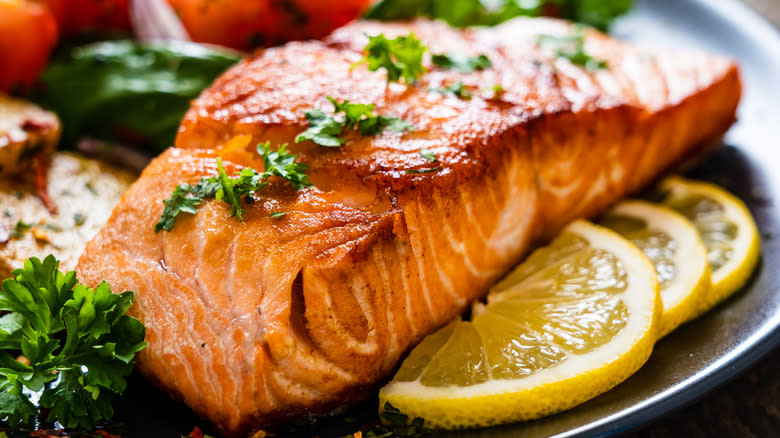
Prized for its buttery flavor and tender consistency, salmon is one of the most popular fish choices in America. Deliciously rich and healthy to eat, salmon is packed full of flavor and health benefits. Teeming with omega-3 fatty acids that generate energy and build cell walls throughout the entire body, salmon offers an extraordinary mix of flavor and nutrition. Despite its popularity among consumers, there's a good chance that many can still use some tips and general guidance surrounding this wondrous and delicious fish. Even if you feel that you've mastered the art of preparing salmon, it's always a good idea to stay open-minded. Learning more about the food that we eat and acquiring some new tricks in the kitchen is always worth it.
From how to prepare the skin and prevent sticking on the grill to an easy fix if you don't have any fresh lemons on hand, we cover all of these bases and more based on proven cooking methods and tips from experts and professionals. If you're a salmon lover or a just curious cook looking to expand your repertoire, you're in the right place. Read on to scope out 10 salmon secrets you'll wish you knew sooner.
Read more: 12 Underrated Types Of Fish You Should Try At Least Once
Parchment Paper In The Pan Can Prevent Sticking
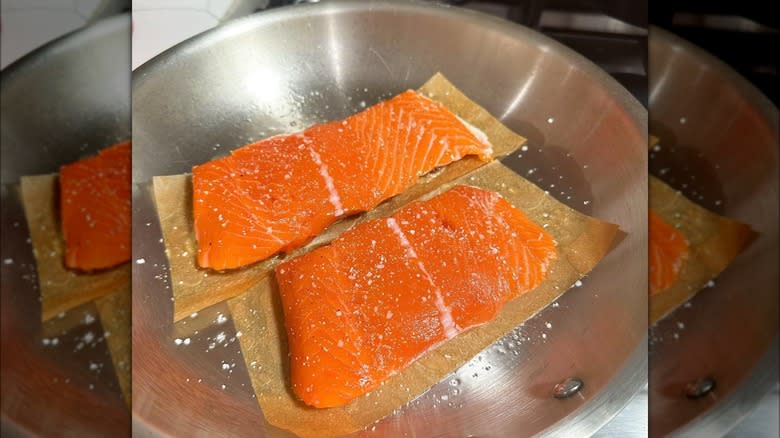
When most of us use parchment paper, we tend to use it to line pans for baked goods like cakes. Until recently, it never even occurred to us to use parchment paper inside of a pan to make it nonstick. But as it turns out, cooking in a pan with parchment paper can produce spectacular results.
This method proves especially useful with fish, which is notorious for sticking. You might be understandably wondering if the salmon can still get crispy this way, and we're happy to report that the answer is a resounding yes. According to chef and cookbook author J. Kenji Lopez-Alt, cooking with parchment paper should be safe at temperatures up to 450 F, which is about the temperature cakes are often browned in the oven with parchment paper.
Stainless steel pans are great to cook with but can be difficult to clean. This parchment paper trick changes that. By preventing stickage and making the salmon easier to flip, parchment paper slips in to save the day. Just be careful and make sure to oil the salmon and the pan before you lay the parchment paper down.
Soak The Salmon In Milk To Neutralize Its Scent
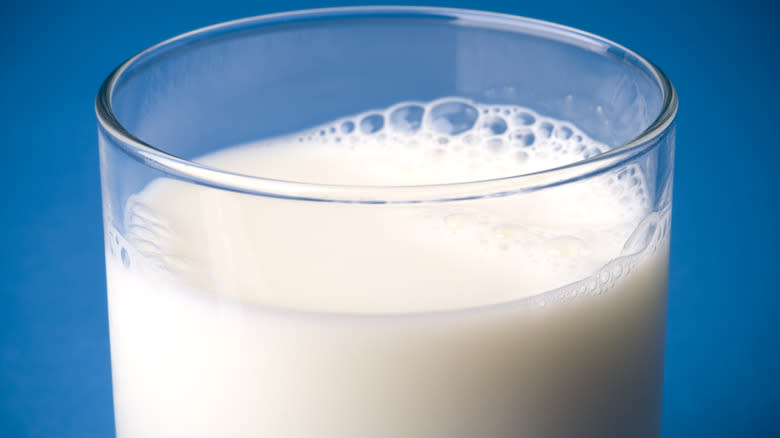
Delicious as it is, the smell of fish is often considered unpleasant. Of course, fresh fish should never be overly smelly. If fish has a sour scent or a slimy texture, those are signs that it's spoiled and unsafe to eat. But the reality is that even just the subtle scent of perfectly fresh fish can still be a little off-putting, especially when it gets more amplified while it's cooking in the kitchen. Fortunately, there's a secret ingredient you can use to offset salmon's inherent smell and there's a good chance that you already have it in your fridge.
Soaking salmon in milk before cooking has been shown to neutralize its scent. Milk proteins, which contain nutritious amino acids, bind to the fatty acids contained in salmon and reduce its scent. Tests have shown that soaking salmon in milk for only 20 minutes can produce fantastic results, practically eliminating its fishiness. Just be sure to rinse the salmon off after soaking it in milk before cooking it as you normally would.
Cook Your Salmon Over Fresh Slices Of Lemon On The Grill
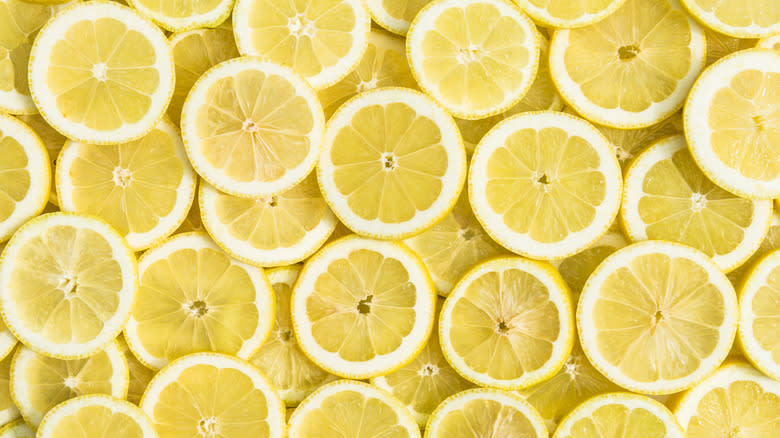
Nightmare scenario: you bought a beautiful, pricey piece of salmon to cook on the grill, but when you flip it, it's stuck to the grates. As you struggle to pry it off, the flesh peels away, leaving you with a disfigured filet that looks like it belongs more in the trash than on your plate. The good news is that we have a simple trick up our sleeve to stop this from happening.
The first thing you want to do is make sure that your grill grates are clean. Give it a good scrub with a grill brush, taking care to scrape off any chunks. Once it's clean, put some high-temperature oil on a paper towel (avocado oil is a good choice because it has a high smoke point) and rub the oil along the grates. You don't want the grates to be dripping oil, but you want them to be thoroughly coated. Not only will this help make your grates non-stick, but it will also protect them from rusting.
Next, slice some fresh lemons and gently rub them in a little oil. Lay the lemons down on top of your grill grates. You want to lay them down in a way that will accommodate the size of your salmon filet. Then place your salmon on top of the lemons. The lemons will act as a barrier between the grill grates, preventing sticking, while also adding some fresh citrus to the flavor as it cooks.
Use A Cast Iron Pan
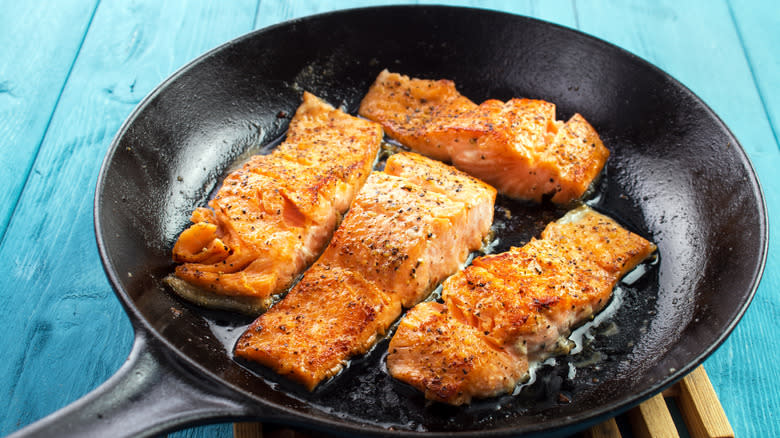
When it comes to cookware, it's hard to beat a cast-iron skillet. Cast iron is durable and also produces blistering heat that allows for some serious crispiness. It also retains that heat, which means that once it's hot, it stays hot. Cast iron is safe to use on the stove and in the oven, so it's easy to transition from searing to roasting.
Start off by heating up a seasoned cast iron pan on the stove. Don't add any extra oil yet — just heat up the pan for a couple of minutes over the burner. Once the pan is hot, add a little oil and swirl in the pan to evenly coat the bottom. When the pan is about 325 to 350 F, add your salmon to the pan. If your salmon has skin, put it skin side down first. Let it cook until it's crispy, then flip and cook for a few more minutes.
You can finish your salmon on the stove until it's cooked through, or slide it in the oven to finish cooking it. The best approach here depends on its thickness — a thicker filet might be better off in the oven after searing on the stove. The best way to achieve precise results is to use an internal digital thermometer. The USDA recommends cooking salmon until it has reached an internal temperature of 145 Fahrenheit, but many others recommend a slightly lower temperature (around 125 Fahrenheit) to prevent toughness from overcooking.
Dry Brining Overnight Works Wonders
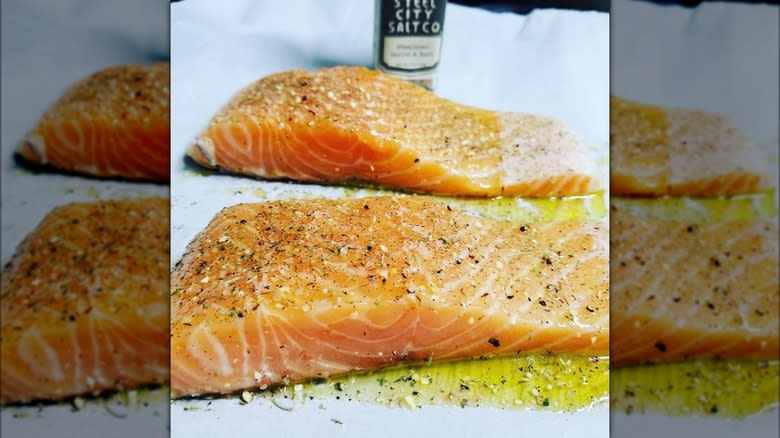
There are plenty of options when it comes to flavoring salmon. Ideally, by the end of the cooking process, the salmon is moist and tender, easily flaking off into succulent pieces with just a gentle pull of your fork. What we really want to avoid at all costs is salmon that's tough and dry from overcooking. We're aiming for salmon that's firm, yet still delicate and juicy. And one of the best ways to achieve that is by dry brining the salmon filets overnight.
Dry brining salmon is easy. All it really amounts to is salting the filets and then letting them rest in the refrigerator overnight. Dry brining will accomplish a few different goals that will all benefit your end result. Salt breaks down proteins with the passage of time, which allows the salmon to retain more of its natural moisture. This means that dry-brined salmon tends to be much more forgiving if it's a little overcooked. As proteins in the filets dissolve from being salted overnight, dry brining will also reduce the amount of the salmon's albumin (which manifests as white, gunky globs that are secreted from salmon during the cooking process). This results in a cooked piece of fish that looks much more appetizing. The salt will also help crisp up the skin, which adds some delicious texture and flavor to the salmon.
There Are Nutritional Differences Between Types Of Salmon
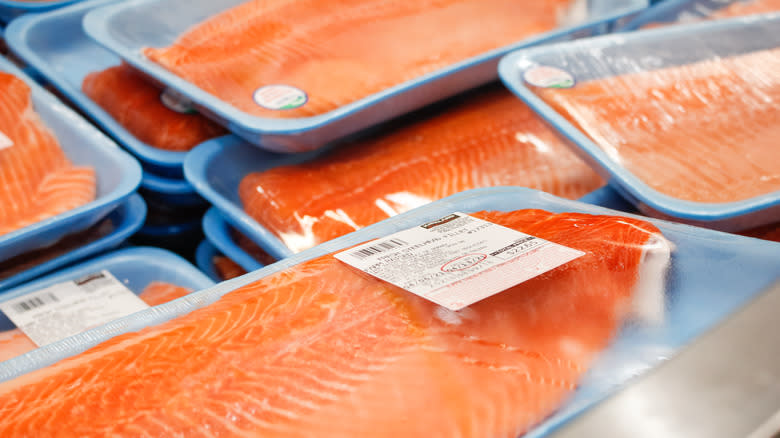
There are a lot of choices on the market when it comes to salmon. Two main camps are farmed salmon and wild salmon. Some say that it's best to avoid farmed salmon since the differences between salmon farms haven't been made clear enough in labeling to help consumers make an informed decision. The chemicals used to raise farmed salmon are seldom disclosed on the label, despite the possibility that farmed salmon can be raised on synthetic additives to imbue the fish with the pinkish hue that consumers expect. Wild salmon, on the other hand, typically has a deeper color that's naturally acquired through digesting pigmenting compounds in a diet rich with shrimp and krill.
The fat content of wild versus farmed salmon can also be surprisingly different. While a typical serving of wild-caught salmon contains about 5 grams of fat, that same amount of farmed salmon contains three times that amount. At the same time, wild salmon contains more cholesterol, yet also more calcium. One important area where both wild-caught salmon and farmed salmon are nearly identical is protein. Because wild salmon is often much more expensive than farmed salmon (costing up to four times the price per pound), it's important for consumers to factor in their unique dietary needs along with their budget to make the best decision when shopping.
Save The Pan Drippings For A Sauce
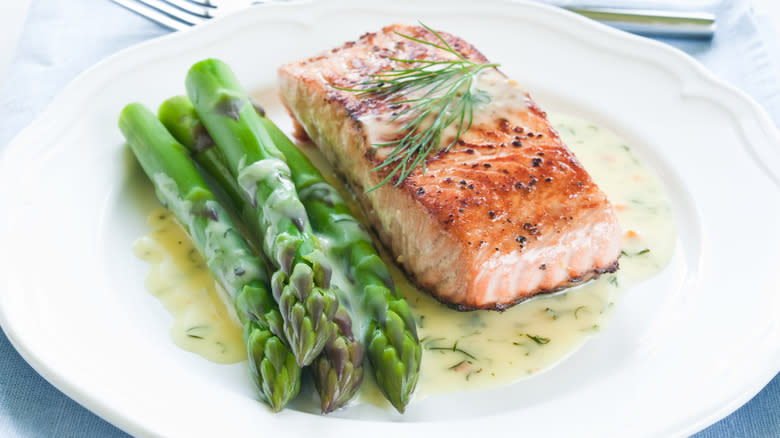
Cooking your salmon in a pan offers a great opportunity to make a sauce. Rather than using another pan, you can simply make the sauce in the same pan that the salmon is cooking in. Once each side of the salmon has been browned in butter, deglaze the pan with white wine and some fresh lemon juice. Be sure to scrape up the drippings at the bottom of the pan to incorporate extra flavor into the sauce.
After the wine and lemon juice have simmered for a couple of minutes, add a splash of heavy cream and fresh herbs, such as parsley and dill. Reduce for a couple of minutes over low heat, until the sauce is thick enough to stick to a spoon but thin enough to spread like a glaze. Season to taste, then drizzle the sauce over your salmon and serve. Salmon is perfectly delicious with just some basic seasonings, but finishing it off with some sauce takes it to another level that's totally worth it.
For The Best Results, Prep Up The Skin
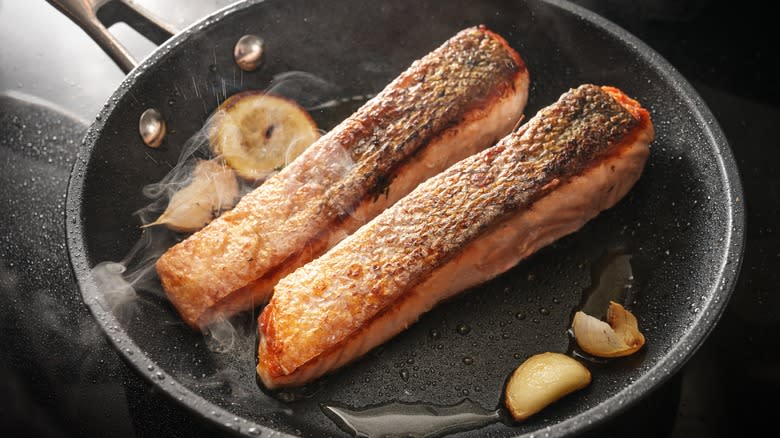
Some home cooks might be a bit intimidated by working with salmon skin. Instead of buying salmon with the skin attached, they might purchase skinless salmon to just avoid it altogether. But the truth is that salmon skin is astoundingly delicious when it's crispy, and provides a nice contrast to the filet's tender juiciness. It's also quite easy to prepare and only takes a few steps.
First, make sure to thoroughly dry the skin. You can easily do this with a paper towel. Excess moisture will prevent the skin from getting crispy, so the drier it is, the better. Preheat your pan and while it's warming up, gently rub some high-temperature oil on the skin. When the pan is hot, lay the salmon down skin side first, then press it down a little more to flatten the skin out. When the edges of the skin start to turn a golden brown, feel free to gently lift it up and take a peek to monitor its progress. When the skin is crispy and lightly browned, flip it over and finish cooking for a few more minutes. Sprinkle a little salt onto its golden brown skin while it's still hot so that the salt can stick to it. When the skin is cooked correctly, it should be crispy and lightly salted like a chip.
Cook Extra And Use Leftovers For Salmon Cakes
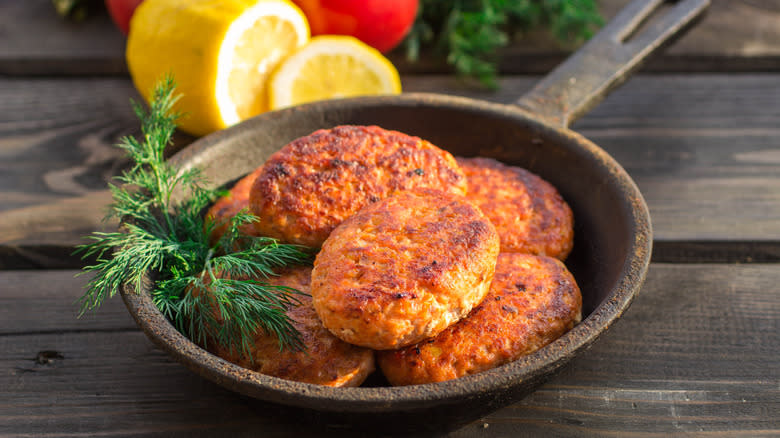
Ensuring that you have some leftovers can simplify the next meal that you make. By cooking some extra salmon, you're presented with the perfect opportunity to make some salmon cakes the next day. Salmon cakes can be used as an appetizer, served as an entree with some vegetables, or even turned into patties for salmon burgers. Whipping up salmon cakes is basically the same as making tuna salad with just a couple of extra ingredients. Then when the salmon cakes are mixed, you'll sear each side until they're golden brown.
To make salmon cakes, gently flake apart and shred the filets into a bowl. Add chopped scallions and fresh dill followed by one beaten egg, some mayonnaise, and panko bread crumbs. Next, add a little bit of Dijon mustard and a squeeze of fresh lemon juice along with salt and pepper. Mix to combine and form into patties. Cook in a well-oiled pan until each side is crispy, which should take around three or four minutes per side. By cooking a little extra salmon the first time around, you've made a completely different meal with minimal fuss.
If You Don't Have Any Lemons, Try Using Orange Juice Instead

The refreshing pop of lemon uplifts salmon in a way that other fruits just can't do. But don't worry if you find yourself lemonless — there's a good chance that you can still add a twist of fruity citrus to your salmon as long as you have a common beverage in the fridge. Orange juice is an easy way to introduce a similar flavor profile, and turning it into a glaze couldn't be easier.
In a saucepan, combine orange juice with ginger, garlic, green onions, and a splash of soy sauce. Add a little honey, rice vinegar, and water then bring to a simmer for a few minutes. In order to thicken into a glaze, add a cornstarch slurry (which is just two parts cold water to one part cornstarch). Taste the glaze along the way and adjust it to your liking. The cornstarch slurry should give the orange glaze a glossy consistency that will beautifully stick to the salmon. Who knew running out of lemons could be a blessing in disguise?
Read the original article on Daily Meal.
